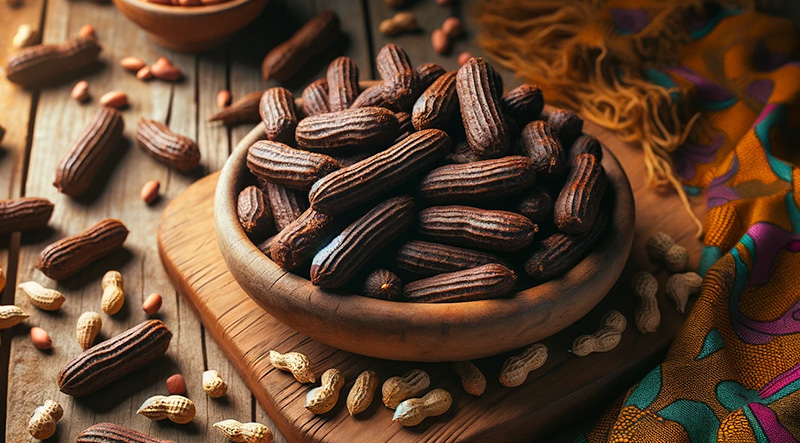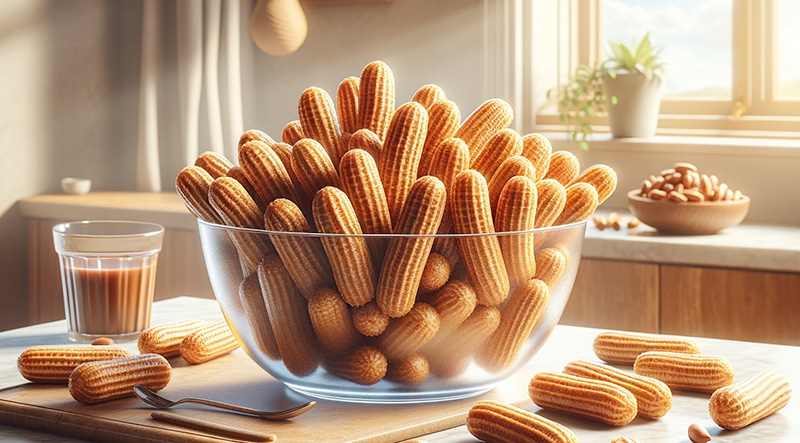Kuli-kuli is widely recognized as the national dish of Benin. This traditional snack is deeply rooted in Benin's culinary heritage and is enjoyed during various occasions such as festive celebrations, family gatherings, and religious ceremonies. It is made from ground peanuts, formed into various shapes, and then deep-fried. Kuli-kuli is cherished for its taste, nutritional value, and the cultural memories it represents in Benin. It's a simple yet nutritious food, often enjoyed as a standalone snack or as part of a meal, While there is some discussion about other significant dishes in Benin, like Amiwô with Fish, it appears that Kuli-kuli holds a special place as a representative national dish, reflecting the country's culinary traditions and cultural heritage. Read More...
Kuli-kuli is made from groundnut (peanut) paste, which is typically left over after the extraction of groundnut oil. This paste is mixed with local spices, formed into various shapes, and then fried. The process of making kuli-kuli provided a way to use the by-products of groundnut oil production and turn them into a nutritious and portable snack.
Over time, kuli-kuli has not only become a popular snack but also an integral part of the culinary culture in West Africa. It’s often consumed as a standalone snack, used as a complement to dishes like porridge, or ground into powder as an ingredient in other recipes.
The snack’s popularity and significance stem from its simple yet nutritious composition, its deep cultural roots, and its versatility in various dishes and occasions. Kuli-kuli reflects the resourcefulness and culinary creativity of the people in the region, making it a cherished food item across West Africa.
Extract Oil: If you are using whole peanuts, first roast them, remove the skins, and then grind them into a paste. You need to extract some of the oil from this paste. Traditionally, this is done by wrapping the paste in a clean cloth and pressing it to squeeze out the oil.
Season: Once you have the peanut paste with reduced oil content, mix in the cayenne pepper, salt, and ginger (if using). The consistency should be such that you can shape it.
Shape: Form the paste into small balls or cylindrical shapes. Some people also make small discs or other shapes according to their preference.

Fry: Heat the vegetable oil in a deep frying pan. Once hot, add the kuli-kuli pieces and fry them until they are golden brown. It’s important to keep the oil at a medium temperature to ensure they cook through without burning on the outside.
Drain: After frying, remove the kuli-kuli from the oil and place them on paper towels to drain off any excess oil.

Cool and Serve: Let the kuli-kuli cool down before serving. They can be enjoyed as a snack on their own or used as a crunchy addition to various dishes.
Remember, you can adjust the amount of spices to suit your taste. Kuli-kuli is not only tasty but also packed with protein, making it a nutritious snack option. Enjoy your homemade Kuli-kuli!
The time required to cook kuli-kuli can vary based on the recipe and the quantity being prepared. Typically, the process involves grinding peanuts into a paste, mixing it with spices, shaping it into desired forms, and then frying. The preparation of the peanut paste and shaping the kuli-kuli might take about 10-15 minutes. The frying process usually takes another 10-15 minutes. Overall, you can expect the total cooking time to be around 20-30 minutes. This timeframe is ideal for small to medium batches of kuli-kuli, and it could be longer for larger quantities or if additional steps, such as roasting the peanuts first, are included in the recipe.
A typical serving of kuli-kuli, which is about a small handful or roughly 28 grams, contains approximately 150-200 calories. The calorie content can vary depending on the specific recipe and the size of the serving. Kuli-kuli is primarily made from groundnuts (peanuts), which are high in protein and fat, contributing to its caloric content. The snack is also often flavored with local spices and sometimes salt. Its nutritional profile makes it not only a calorie-dense snack but also a good source of protein. However, due to its high fat content, it should be consumed in moderation, especially for those monitoring their calorie intake.



